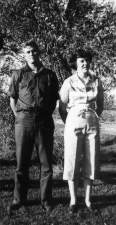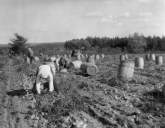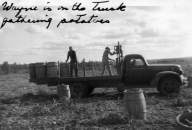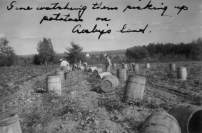| A-CHS NEWSLETTER
Established 1980
Here are some articles from our Issue 107, November
2000 LOCAL BUSINESS – GROWING POTATOES Dyer Crosby grew-up on his parents’ farm on the North Union Road, just south of the Alexander/Cooper town line. He married Hilda Gillespie on September 2, 1944 and then went off to war. He shipped out of San Francisco, California on August 15, 1945, the day the Japanese surrendered. After spending time in Korea, he returned to Hilda, to Cooper, and to the farm on which he had grown-up. Dyer’s parents, Coburn and Yola (Lane) Crosby had run a general farm here since their marriage in 1915. (The farm had been created by Yola’s father, Civil War veteran Francis Lane and his wife Eliza Jane Strout). For several years, Dyer continued in general farming. While Coburn had taken farm products to Milltown and Calais, Dyer hauled his products to Machias. Dyer sold chickens and eggs. He sold eggs to Helen and Larry Mugni when they first opened Helen’s Restaurant in Machias. He sold potatoes, blueberries, and peas. He decided potatoes would be a good crop because at that time there was a price support program for their production. In 1947, Dyer used the horse and horse-drawn equipment
to plant potatoes on his parents’ farm and on nine acres he rented
from Ralph Sadler on Middle or Grove Ridge in Cooper. He then purchased
a tractor to haul the potato digger, which was designed to be pulled by
horses. For the In 1953, Dyer started growing potatoes in Alexander. Over a period of years he acquired over 60 acres of cropland, some on the Flat Road and some of the Spearin Road. Not all the cropland was planted to potatoes each year. For crop rotation, Dyer would plant winter rye on a potato piece either just before or just after the spuds were picked. Late the following spring, the rye would be plowed under and the same fields would be planted to Japanese millet. In 1958 he had a potato cellar or potato house built for storing potatoes until the market was good. This building was a University of Maine design and was built by Ken Sawyer of Charlotte. It has the capacity of 5500 barrels. This building still stands near the Custer Dow house-site at the intersection of the Flat and Nellie Berry Roads. Dyer realized that water was needed for a good crop
of potatoes, so he dug three irrigation ponds at the Flat Road site. He
found that he could grow more potatoes on 35 acres of irrigated land
than he could on 50 acres without irrigation. He used two Chrysler
gasoline engines to power his irrigation pumps. These would pump 400 to
500 gallons per minute. He would place the 6-inch and/or 4-inch aluminum
irrigation pipe between certain rows during the day, and then run the
pumps from 6 until about 11 each night. Actually, he would fill each
pump with 30 gallons of gas, and let them run till out of fuel, about
41/2 hours. The next day, he’d move the pipe to the next area to be
irrigated, then apply needed sprays to the area watered the night
before. These sprays were to control the Colorado potato beetle, flea
beetles, and early and late blight. Some of the spray cost $50.00 a
gallon! Dyer had lots of help raising potatoes. Some of the women who planted and/or picked potatoes were Ethel (Knowles) Hunnewell, Thelma Hunnewell, Connie McArthur, Alberta (McArthur) Berry, Eunice Carlow, Althea (Davis) Lord, Velma (Davis) Johnston, Ina Leighton, and Bertha Hatt. Aldena Moriasey of Crawford would pick 100 barrels of potatoes in a day and want Dyer to dig more! Ulric Magoon and his family also helped in picking. Ned Hatt was an unusual picker. He had but one leg, so would pick up sitting down. He’d drag himself along, and pick quite a few barrels in a day. His brother Carl would haul the full baskets to the barrels for him. Charlie Moholland helped Dyer in planting season. Dyer hired "day men" to help during the harvest. These men worked on the truck. They included Clarence Leighton, his son Kenny, Shirley Hunnewell, Wayne Dwelley, and Roland Perkins. Morey Hunnewell worked in the bin, inside the potato house. Gerald Cooper and Leslie Knowles were two of the high school students who helped move the long sections of irrigation pipe. During these years Hilda had the contract to transport school children, first to the East Ridge School in Cooper, then to the new (1956) school in Alexander, and finally to Woodland. This involved at least two trips a day and three when there were kindergarten children to bus at noon. Even with this schedule, Hilda helped Dyer with many of the chores such as planting (cutting seed and dropping seed), moving irrigation pipe, and grading in the potato house. Grading meant picking out the bad potatoes, sunburned, bruised, cut, or crooked ones. Hilda would even drive a tractor when called upon! Dyer had a machine that sorted the potatoes by size, 1 ½" to 2 ¼" for seed, 2 ¼" to 3" for table stock, and 3" to 4" for chefs. Chefs were for making French fries and many were sold to St. Croix Valley Drive-in Theater in Baring. Dyer raised his own seed potatoes, under control of the tuber unit of the state seed farm. He had help from local women planting seed (which for those who never have grown potatoes are pieces of potato with at least one eye in each). The seed was cut and planted at the same time, by hand. This way, all the pieces of seed from one potato was planted next to one another. If the seed was diseased, then it was easy to pull the plants, which were growing next to each other.
These were also the potatoes that Dyer sold. Since
they were inspected seed, they could be sold for a good price, if other
potato growers had lots of money. Dyer sold seed to farmers in the
Newport – Exeter area. When these farmers had a financially successful
year, they would buy Dyer’s seed. When the potato price was down, they
usually would cut corners and plant their own seed. Dyer’s best year
selling potatoes was 1965. That year he profited about $45,000. One year
was so bad he sold his certified seed as table stock on the Boston
market for $1.00 a hundred weight. That was the delivered price and Dyer
had to pay 25 cents for the bag plus a cent for the tag! Some potatoes
were shipped to market by truck and others were loaded on rail cars at
Woodland. Dyer could grow a good crop of potatoes each year. But the market was not good most years so that by 1969 Dyer was $7000 in debt. He sold off some equipment to balance the books and went into the construction business. From 1947 until the present year Dyer and Hilda have harvested blueberries from their farm in Cooper. For a few years they grew an acre of strawberries in Alexander, and they kept a small herd of Hereford cattle. VAREN CRAFTS: EARLY SETTLER Varen Crafts was a brother of Isaac Porter Crafts and their ancestors are found listed in issue 105. Information for this article came from Pliney Frost’s work on this family. Additions and corrections are welcome. Varen was born at Hebron, Oxford County, Maine on October 17, 1800. As a young adult he went to New Brunswick where he was engaged with his brother Isaac in navigation of the St. John River between Grand Lake, Fredericton and St. John. He married Jane Ferris on October 7, 1829. She was born at Waterborough, Queens County, NB on July 2, 1808. She was the daughter of John and Mary (Stillwell) Ferris. She was a sister of Isaac’s wife Rebecca. They moved to Alexander before the 1830 census and lived here for about 30 years before moving to South Princeton. Jane died on May 23, 1870 and Varen died on April 7, 1871 at Princeton. Their children were probably all born in Alexander:
Varen and Jane Crafts are buried in the Alexander Cemetery, as are these children: Margaret A. died March 10, 1834, age 4 months, (who is this?) Mahala died July 20, 1842, age 5 years, 7 months Sarah J. died September 20, 1845, age 5 years, 1 month, (this date does not agree with above) Alonzo died March 5, 1846, age 14 years, 3 months (the year of death does not agree) Frances A. Died May 17, 1855 These stones are broken, in poor shape and thus hard to read. LELA SCRIBNER’S 1925 DIARY - MARCH Again with thanks to Mildred (Flood) Holst, we continue looking at life in Alexander through the diary of Lela (Crafts) Scribner. A sample of the original work is copied here. 1 – Sunday - Bertha and Leon to James’s to supper; Frank and Ella called. 2 – Monday - men killed calf Jennie in a.m.; Mort and Thed down in woods in p.m.; Leon to Calais; Thed here to dinner and supper; Florice and Vira and children called. 3 – Tuesday - Leon to Calais; Mort hauling wood. 4 – Wednesday - men hauling wood and picking up a load; Women here to practice for the pantomime; Ada and Mabel here to supper. 5 – Thursday - Leon and Merton to Calais; Mort hauling wood; Bertha and I called to Winnifred; Merton here to supper. 6 – Friday -raining in a.m.; Mort finished hauling wood. 7 – Saturday - men sawing the rest of the poplar; Thed here to work; Bertha and Leon down to Ina’s; Women met to practice pantomime. 8 – Sunday - we were to Calais; snowing. 9 – Monday - men down to Thed’s to help haul wood in dooryard; Leon and Thed killing his calf; Alice Staples here to dinner; Hi called. 10 – Tuesday - cold, froze hard last night; Leon and Thed to Calais with calf; Mort getting out cedar. 11 – Wednesday - raining; Bertha and I to Ada’s to dinner; Leon and Bertha called on S. Perkins. 12 – Thursday - Leon to Calais; Mort getting out cedar; Vira and children called; Velma Slovich baby born, Dr. Stewart, Lindon Leroy, son of Mr. and Mrs. Nelson Frost, born. 13 - Friday - men sawing spruce; Thed and Ivan here to dinner and supper; Clinton called. 14 – Saturday - snowing and colder; Leon to store. Alton Perkins and Ola Flood married. 15 – Sunday - squally; we were all to Thed’s to dinner, went on sled. 16 – Monday - men down to Thed’s to finish hauling out wood to house; Leon killed calf; Frank here to saw up calf. 17 – Tuesday - Leon to Calais; Billy went home; men getting out cedar; Frank here. 18 – Wednesday - men sawing spruce; Thed and Ivan here to dinner and supper; Bertha out to Carrie’s camp warming; I called to Ella’s; Clinton and Vira called. (Bert and Albert Varnum had built a camp in the woods near the edge of a field. Each spring their mother would cook a big chicken stew and many family members and young neighbors would go to the camp warming. They would play cards and other games, have stew for dinner, and have a good time. Earl and Lindsay didn’t attend, but one year Lindsay sneaked up and stuffed the stovepipe with something that smoked them out. 19 – Thursday - cloudy and misty; finished sawing spruce and moved to Frank’s; Thed here to dinner; Eva and children here to dinner and supper; raining and thundering; Leon to store; Leon and Bertha to Floyd’s 20 – Friday - men sawing Frank’s wood. 21 – Saturday - men finished sawing Frank’s wood and moved over here in forenoon; all to Grange; Winnifred called; Edith McLellan was operated on. March 22 through March 30 have no entries. 31 – Tuesday - Mort splitting wood; Thed in Calais; Ina and girls here to supper; Florice here to supper; raining. OUR DOWNEAST LAKES – PLEASANT LAKE WILLOW LANE Willow Lane runs west from the Cooper Road. The land here was part of that acquired by John Dwelley and his grandson Hubert sold four of these lots. Dane Dwelley, Chris Landry and Mary Landry helped with this article. Additions and corrections are welcome. 8) Arthur and Freda Fleming of Woodland got this lot in the late 50’s and started building a camp. After a couple of years they sold to Earl and Mary Landry of Alexander. Earl finished the camp and the family used it for years. Since Earl died in 1992, Mary has not used the place very much. 9) Orland and Alice (Gaddis) Williams of Alexander bought this lot in February 1956. They moved in a trailer for a camp, which they used over the years. Orland died in 1984 and Alice still occasionally uses her camp. 10) Lindsay McLaughlin of Baileyville acquired this lot in June 1955 and built a camp. In June 1961 he sold the lot and camp to Earl and Mary Landry. Allan and Hilda (Cousins) Greenlaw bought the place in June 1968 and used it for awhile until the bought a place on Cozy Cove Lane. The sold this camp to Chris Landry, son of Earl and Mary, in 1998. Chris is converting the building into a year-round home. 12) Olaf and Harriet (Seamans) Dwelley got this lot before 1963. Shortly after they moved a "St. Croix woods camp" down across the lake with horses and set it up on this lot. Olaf was a son of Oliver and Hazel (Crafts) Dwelley and a nephew of Hubert. Olaf and Harriet, both veterans, are buried at the Alexander Cemetery. Their son, Dane who lives in Old Town now owns the camp and in 1994 did a major renovation on it. 14) Cecil Hatfield had acquired some Dwelley property in the 1940’s and sold this lot to Oliver and Christine Dwelley in 1953. In June 1972, Christine (Dwelley) Morgan of Lakeland, GA sold the lot and building to Arnold and Katherine Kidder of Woodland. The building was apparently a trailer that had been brought out from near Woodland High School in the early ‘60’s. Katherine and Arnold divorced and Katherine married a Greenlaw. She still owns the place. A-CHS BIRTHDAY CARDS: A-CHS has created a new birthday card for 2001. We’ll mail this card to each native (Alexander or Crawford) born person who is 75 or older. If you fit and did not get a card this year, send us your name and address and we’ll put you on the list GENEALOGY FAIR: The 2001 fair will be at Alexander Elementary School on July 7th from 10 until 3. Mark this on your calendar. It’s a great chance to learn about families from this area. LIMITS OF HIGHWAY SURVEYORS FOR 1895 The job of the highway surveyor was to oversee work done on the road. At this time in history, part of each person's tax was a highway tax, which usually was paid in labor (of man and/or animal) on the road. Someone had to be the boss, and the highway surveyors filled that roll. Of course, their time could be credited against their highway tax. Following each number in italics is the quote from the Alexander Assessors' Book. Next in (parenthesis) comes an explanation of where each section of road is located in 2000 terms.
We note that the Green Hill Road was not surveyed. The town-line between Alexander and Cooper had been changed by the Damon Set-off of 1838. The actual location of the line was not settled until 1900. Therefore, in 1894, the assumed line was 50 rods north of the legal line and the Green Hill Road was almost entirely on the Cooper side.) THE TALE OF TWO THE HARRIETS In issue 106 we had an article on The First Settlers of Cooper based on an 1897 interview with Thomas Burbank. Austin Gray, who copied that article, had added some notes about Burbank, which are the basis for the following. We have referred to Cooper censuses, cemetery stones, vital records, Memorial of the Loyalist Families of Moore, Hitchings, and Livingstone by John E. Moore, The Leland Magazine by Sherman Leland, Our Heritage: Howes and Lanes by Charlotte Stole, plus A-CHS files. Additions and corrections are welcome Thomas J. Burbank was born on March 19, 1816 in Trenton, Maine. He moved to Cooper as a child with his parents, Deacon Johnson and Abigail Burbank. Through his marriages Thomas became connected to many Cooper residents. Thomas married first Harriet Hitchings (1816). She was a granddaughter of Josiah and Anna (Livingstone) Hitchings who had moved from New Boston, New Hampshire to St. David, New Brunswick. Harriet's parents were David and Sally (Loring) Hitchings who moved to Cooper before 1830. They had 10 children, the youngest, David (1799) died young. Harriet's sister Mary (1801) married Benjamin Henderson and they lived in Cooper. Her brother Henry (1810) married Margaret Brown, daughter of Joseph Green Brown, and they, too, lived in Cooper. The next younger brother, Hiram (1813) married Mary Florence Howe, daughter of Asa and Susan (Fisher) Howe. They were living in Cooper in 1850. Harriet's younger sister Rachel (1821) married Charles William Palmeter and also lived in Cooper. So Harriet Hitchings and four of her siblings married and lived in Cooper. Thomas and Harriet (Hitchings) Burbank had 8 children according to the "Hitchings" book, Henry J., Julia, William, Moses, Sylvester, Harriet, Abbie, and Edmund A. The 1850 census lists Henry, Julia, Thomas W. (William), Moses J., Sylvester, and Harriet. The 1860 census adds Edmund. In that census we find two Abigails in the household, Abigail Burbank age 77, and Abigail Seavey, a 28 year-old tailoress. But we don't find a reference to a child named Abbie. Thomas's wife Harriet Hitching had died in 1855 and was buried at the East Ridge Cemetery. Thomas married next Harriet (Leland) Howe (I 828). This Harriet was a daughter of Moses and Jerusha (Norwood) Leland. Her siblings were Moses (I 826), Hannah (I 830), Abner (I 832), and Thomas (1835). Was there a sister Ruth (1825)? Harriet Leland first married Mark Howe, brother to Mary Florence mentioned above, after Mark's first wife Ruth Leland had died in 1850 (buried at East Ridge Cemetery). Mark and Ruth's two children disappear from the record after the 1850 census. In that census they are listed as Lucius (I 843) and Leroy (I 845). Charlotte lists their names as Lucian and Lucy. Harriet's brother Moses married Hannah Shackford and lived on the North Union Road by Dead Stream, Abner and Thomas Leland married Conant sisters from Charlotte, Mary and Margaret respectively. Abner and his family were long time residents of Princeton before removing to Orono. A picture of Abner and two of his sons was printed on page one of issue 63. Hannah disappears from our records. Mark and Harriet (Leland) Howe had two children, Herbert and Mark, Jr., before divorcing. Mark Howe, Sr. then disappears from our records. In the 1860 census Harriet (Leland) Howe and young Mark are living in the Thomas Burbank home. She is listed as a tailoress. Herbert is found in the James and Jerusha Tyler home with two other (likely) unrelated children of similar age, Laura Homan, age I 1, and Margaret McGeorge, age 7. The Tylers came to Cooper before 1830 and lived on the North Union Road next door to Moses Leland's. James Tyler was a teacher and a wheelwright as well as a farrner. By the 1870 census Thomas and Harriet Leland were married and Herbert had joined his mother and brother in the Burbank home on the East Ridge Road. The Burbank and Leland families had each come from Hancock County, the Burbanks from Trenton and the Lelands from nearby Ironbound Island. ADDITIONS AND CORRECTIONS TO PAST ARTICLES BILLY WOODRUFF AND THE LYLE PLACE - Joe Dwelley, 536 Squire Lane, Kississimmee FL 34746, told us that William Woodruff was known as "Billy" by many of his friends. What we labeled as WOODRUFF'S HOUSE in issue 104, page 6 was called the "Lyle Place" by Luther Thornton the day he showed me the cement posts that mark the site. Joe said that the "Lyle Brothers" were from Boston, had a Hudson dealership there, and had this hunting and fishing camp in Crawford. Pearl Woodruff was their guide and they brought him a big old high-back Hudson car, which he used for many years. OUR DOWNEAST FAMILIES Query from Kenneth Willey, 3 Putnam RD, North Reading MA 01864 LITTLE LIFE STORIES OF MAINE PEOPLE: A series of articles under this heading appeared maybe in the 1920's in a newspaper that must have been circulated in Washington County. The column before us is about Mrs. Mary T Wilson, 91, of Cherryfield. What newspaper printed this series? Query from Debby Meffiweather, PO Box 170093, Boise ID 83717 merriweadl@cyberhighway.net GODFREY/ MORRISSEY/ SCRIBNER: I am looking for obituaries and stories about the lives of the following; Rebecca (Godfrey) Scribner (widow of G. S. S. Scribner, Rebecca died in 1915 at Tom Blaney's), her mother Rachel (Morrissey) Godfrey (died after 1880) and Rachel's parents John Morrissey (died 1870) and Ruth (Blakman) Morrissey (died before 1850). Does anyone have a picture of Rebecca I could have copied? I descend from Rebecca and her first husband and have wondered why she left her child with her parents when she moved up the hill, married George Scribner, and looked after his children. |
 next few years Dyer grew potatoes and other crops only
on the home place.
next few years Dyer grew potatoes and other crops only
on the home place.
 At a time when the plants from these seed were
partially grown, Lowell Webster of Springfield and a team of inspectors
would come to rogue the crop or carefully check each plant. This process
was repeated about once a week until the potatoes were in blossom. Any
diseased plant was removed, and the rest allowed to grow and produce
potatoes. These seed potatoes were harvested. A sample was shipped to
Florida, planted, grown, and again inspected for disease. The seed from
these twice grown and twice inspected potatoes were labeled
"foundation seed" if they had less than 1% disease or
"certified seed" if the disease rate was between 1% and 2%.
This was what Dyer planted the following spring.
At a time when the plants from these seed were
partially grown, Lowell Webster of Springfield and a team of inspectors
would come to rogue the crop or carefully check each plant. This process
was repeated about once a week until the potatoes were in blossom. Any
diseased plant was removed, and the rest allowed to grow and produce
potatoes. These seed potatoes were harvested. A sample was shipped to
Florida, planted, grown, and again inspected for disease. The seed from
these twice grown and twice inspected potatoes were labeled
"foundation seed" if they had less than 1% disease or
"certified seed" if the disease rate was between 1% and 2%.
This was what Dyer planted the following spring.